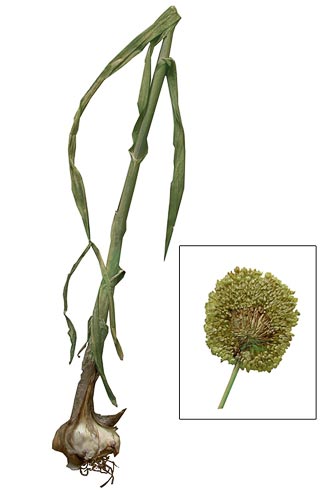Relatives
Allium leucanthum C. Koch. - White-flowered onion.
Taxonomic position.
Family Alliaceae J. Agardh genus Allium L.Synonyms.
A. ampeloprasum var. leucanthum Ledeb., A. firmotunicatum var. album Grossh.Morphology and biology.
Herbaceous, perennial, bulbous plant. Bulb is ovoid-globular with grayish brown outer skin. Skins of bulblet are yellowish. Stem is 50-120 cm tall. Leaves, 4-7 in number, are broad, linear, non-fistular, carinate, 3-9 mm wide, considerably shorter than the stem. Umbel is capsuliferous, almost globular, dense, polyanthous. Tepals are white with a green vein, 3-3.5 mm long, obtuse or acute. Filaments are longer then the tepals; all of them are ciliate, but the outer ones are full, triangular-subulate, while the inner ones are tripartite. Blossoms in June/July. Entomophilous. Propagated by seeds and bulbs.Distribution.
Caucasus (Eastern and Southern Transcaucasia, occasionally in northern of Daghestan).Ecology.
Grows in arid steppes, predominantly in sandy soils, in dry places and in crop fields.Utilization and economic value.
For food (vegetable) and as a source of vitamins.Reference citations:
Galushko, A.I. 1978. Flora of the Northern Caucasus. (Key guidebook). Rostov: Rostov University Publishers. V.1: 164. (In Russian)Grossgeim, A.A. 1940. Flora of the Caucasus. Bakhu: Publishing House AzFAS. V.2: 120. (In Russian)
Vvedensky, A.I. 1935. Onion-Allium L. Flora of the USSR. Leningrad: Publishing House of the USSR Academy of Sciences. V.4: 252-253. (In Russian)


